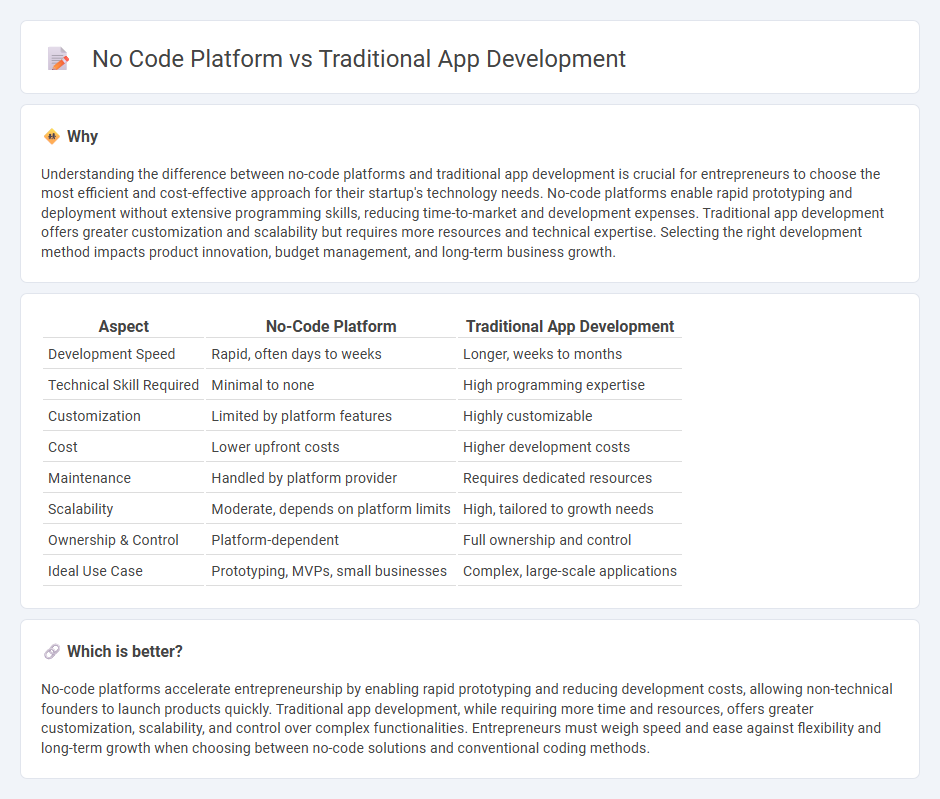
No-code platforms enable entrepreneurs to build functional applications rapidly without extensive programming knowledge, significantly reducing development time and costs compared to traditional app development. Traditional programming requires skilled developers and longer cycles for design, coding, and testing, often leading to higher expenses and delayed market entry. Explore how choosing the right development approach can accelerate your startup's success and innovation.
Why it is important
Understanding the difference between no-code platforms and traditional app development is crucial for entrepreneurs to choose the most efficient and cost-effective approach for their startup's technology needs. No-code platforms enable rapid prototyping and deployment without extensive programming skills, reducing time-to-market and development expenses. Traditional app development offers greater customization and scalability but requires more resources and technical expertise. Selecting the right development method impacts product innovation, budget management, and long-term business growth.
Comparison Table
| Aspect | No-Code Platform | Traditional App Development |
|---|---|---|
| Development Speed | Rapid, often days to weeks | Longer, weeks to months |
| Technical Skill Required | Minimal to none | High programming expertise |
| Customization | Limited by platform features | Highly customizable |
| Cost | Lower upfront costs | Higher development costs |
| Maintenance | Handled by platform provider | Requires dedicated resources |
| Scalability | Moderate, depends on platform limits | High, tailored to growth needs |
| Ownership & Control | Platform-dependent | Full ownership and control |
| Ideal Use Case | Prototyping, MVPs, small businesses | Complex, large-scale applications |
Which is better?
No-code platforms accelerate entrepreneurship by enabling rapid prototyping and reducing development costs, allowing non-technical founders to launch products quickly. Traditional app development, while requiring more time and resources, offers greater customization, scalability, and control over complex functionalities. Entrepreneurs must weigh speed and ease against flexibility and long-term growth when choosing between no-code solutions and conventional coding methods.
Connection
No code platforms and traditional app development intersect by streamlining the software creation process, enabling entrepreneurs to rapidly prototype and validate ideas before investing in customized coding solutions. No code tools leverage visual interfaces and pre-built modules, reducing barriers for non-technical founders, while traditional development offers scalability and customization critical for long-term product growth. The synergy between both approaches accelerates innovation cycles and lowers costs in startup ecosystems.
Key Terms
Customization
Traditional app development offers deep customization through direct coding, allowing developers to tailor every feature, interface, and integration to specific business needs with high precision. No-code platforms provide customization via pre-built templates and drag-and-drop components, which streamline development but may limit complex or unique functionalities. Explore the differences further to determine which approach aligns best with your project's customization requirements.
Technical Skills
Traditional app development demands strong programming knowledge in languages like Java, Swift, or Python to build and customize applications from scratch, requiring expertise in debugging and software architecture. No code platforms minimize the need for coding skills by offering drag-and-drop interfaces and pre-built templates, enabling users with limited technical background to create functional apps quickly. Explore how these approaches impact project timelines, scalability, and technical requirements to choose the best fit for your development needs.
Development Speed
Traditional app development involves extensive coding, often requiring weeks or months to build functional applications, whereas no-code platforms drastically reduce development speed by enabling users to create apps through intuitive drag-and-drop interfaces without writing code. Enterprises leveraging no-code tools report up to 70% faster deployment times, accelerating time-to-market and reducing resource costs. Explore how no-code platforms can transform your app development process with impressive speed and efficiency.
Source and External Links
Low Code vs Traditional Development: What to Choose - Valcon - Traditional app development relies on manual coding, enabling extensive customization, flexible data structures, and full control over the software, typically involving sequential phases of planning, coding, testing, and documentation for complex, enterprise-level projects.
Low-Code vs Traditional Software Development - Kissflow - Traditional app development involves detailed need analysis, technical design, manual coding, iterative testing, integration through custom APIs, deployment on chosen infrastructure, and ongoing maintenance with custom code updates reflecting evolving requirements.
Comparing low-code vs. traditional development - TechTarget - Traditional development offers greater control, flexibility, multi-platform deployment, and regulatory compliance, but is more time-consuming, requires specialized coding skills, and often involves legacy system challenges compared to low-code alternatives.
 dowidth.com
dowidth.com